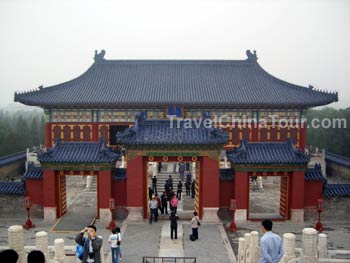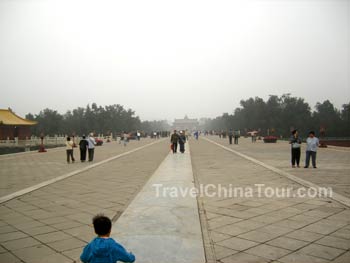Close to the Hall of Prayer for Good Harvests at the Temple of Heaven, is the Imperial Hall of Heaven, which was the "heavenly warehouse" of the Altar of Prayer for Harvests. The day before the ceremony, the emperor came here to burn incense sticks and perform divine greetings for the tablets. After, the tablets are transfered to the Hall of Prayer for Good Harvests. This building was built in 1420 during Emperor Yongle of the Ming Dynasty.

Entrance gate to the Imperial Hall of Heaven.
You can enter the gates leading to the Imperial Hall of Heaven - see photo above. But the hall it self, is blocked off from entry. However, the front doors are open allowing toursits to see inside. Inside the hall, at the center is a tabel with various iron (i think) pots which holds burning incense, and I'm guessing this is where the emperors burned incense sticks.
Keep on heading south, and I exited through to the Danbi Bridge. The Danbi Bridge is the main road (or bridge) leading south to the Imperial Vault of Heaven and the Circular Mound Altar. The Danbi bridge is quite wide, probably at least 5 or 6 lanes in width, and on the two sides of it are grass fields.
Roughly a 10 minute walk south on the Danbi bridge, you come up to the Imperial Vault of heaven. Unfortunately, while I was there, this entire area was under renovation, so tourist had to take a side road around. Just south of here, is the Circular Mound Altar, where worshipping ceremonies were held. The circular Mound Altar was built in 1530 and expanded in 1740. The altar has 3 levels made of white marble - the bottom terreace represents hell, the middle layer represents earth, while the top terrace represents heaven.

A photo of the Danbi Bridge. As you can see, its very wide.
At the very center of the top tier of the altar is the "Heavenly Center Stone". The upper terrace is paved with 9 concentric rings of stone slabs, with a round stone slab in the center of the terrace. If you stand on this center slab of stone, your voice will sound particularly resonant. With so many tourists, there's always a lineup of people waiting to step on the center stone.
After the Circular Mound Altar, I then headed west to the Divine Music Administration. This is where music rehersals for the ceremonies took place during the Ming and Qing Dynasties - it was praised as the highest inistitution of ceremonial music for the Ming and Qing Dynasties.
This Divine Music Administration was built in 1420, and was named the Taoist Temple of Divine Music at that time. During the reign of Emperor Qianlong in 1743, the building was renamed to the Institute of Divine Music", and then again renamed in 1754 to what it is known as today. During the invasion of the Eight Allied Forces, most o the buildings were destoryed.
After the founding of the PRC in 1949, residential buildings were erected on this land. Finally in august of 2004, from the efforts of many scholars and interested social circles, the Divine Music Administration was completely rebuilt, and officially opened to the public - so it's a rather recent addition to the Temple of Heaven.
Inside the building, as the name suggests, you will see all types of ancient musical instruments on display - cast iron bells, drums, bells, flutes, black lacquered Sheng, and so many musical instruments that I have absolutely no idea what they're called. :)
Once I finished with the music hall tour, I exited the Temple of Heaven through the south gates, and headed for my shopping spree at Xidan in Beijing. More on that later! |